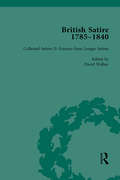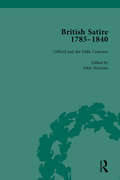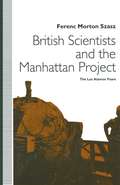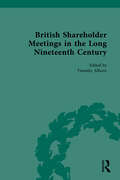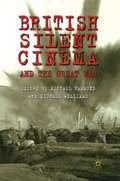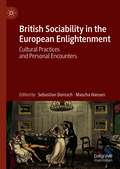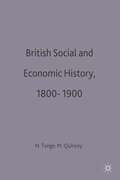- Table View
- List View
The British Sailor of the First World War (Shire Library)
by Quintin ColvilleIn 1914 Great Britain had the largest and most powerful navy the world had ever seen – a well-known fact, but what of the everyday experience of those who served in her? This fully illustrated book looks at the British sailor's life during the First World War, from the Falkland Islands to the East African coast to the North Sea. Meals in the stokers' mess and the admiral's cabin; the claustrophobic terrors of the engine room or submarine; the long separations from loved ones that were the shared experience of all ranks; the perils faced by Royal Naval Air Service pilots in the air; the possessions treasured by sailors while at sea – drawing on a wealth of previously unpublished materials from the National Maritime Museum archives, this is an authoritative and vivid account of lives lived in quite extraordinary circumstances.
The British Sailor of the Second World War (Shire Library #739)
by Angus KonstamThis book tells the dramatic story of how the Royal Navy transformed ordinary citizens into first-rate sailors and navy personnel during the Second World War. It covers how they were recruited and trained and how they endured life at sea in hostile waters, protecting convoys in the Mediterranean, hunting submarines in the Atlantic, and standing up to relentless air attacks in the Pacific. Told through vivid first-hand accounts of life onboard, it reveals what it was like to be a sailor navigating, patrolling, and fighting in the largest theatre of the war – the vast oceans.
The British Sailor of the Second World War (Shire Library)
by Angus KonstamThis book tells the dramatic story of how the Royal Navy transformed ordinary citizens into first-rate sailors and navy personnel during the Second World War. It covers how they were recruited and trained and how they endured life at sea in hostile waters, protecting convoys in the Mediterranean, hunting submarines in the Atlantic, and standing up to relentless air attacks in the Pacific. Told through vivid first-hand accounts of life onboard, it reveals what it was like to be a sailor navigating, patrolling, and fighting in the largest theatre of the war – the vast oceans.
British Satire, 1785-1840, Volume 2
by John Strachan Steven E JonesThis set offers a representitive collection of the verse satire of the Romantic period, published between the mid-1780s and the mid-1830s. As well as two single-author volumes, from William Gifford and Thomas Moore, there is also a wealth of rare, unedited material.
British Satire, 1785-1840, Volume 2
by John Strachan Steven E JonesThis set offers a representitive collection of the verse satire of the Romantic period, published between the mid-1780s and the mid-1830s. As well as two single-author volumes, from William Gifford and Thomas Moore, there is also a wealth of rare, unedited material.
British Satire, 1785-1840, Volume 4
by John Strachan Steven E JonesThis set offers a representitive collection of the verse satire of the Romantic period, published between the mid-1780s and the mid-1830s. As well as two single-author volumes, from William Gifford and Thomas Moore, there is also a wealth of rare, unedited material.
British Satire, 1785-1840, Volume 4
by John Strachan Steven E JonesThis set offers a representitive collection of the verse satire of the Romantic period, published between the mid-1780s and the mid-1830s. As well as two single-author volumes, from William Gifford and Thomas Moore, there is also a wealth of rare, unedited material.
British Scientists and the Manhattan Project: The Los Alamos Years
by Ferenc Morton SzaszDuring World War II, Franklin D.Roosevelt and Winston Churchill pooled their nations' resources in the race to beat the Germans to the secret of the atomic bomb. This book tells the story of the British scientists who journeyed to Los Alamos to help develop the world's first nuclear weapons.
British Shareholder Meetings in the Long Nineteenth Century
by Timothy AlbornThis collection of reported British shareholder meetings originally published between 1800 and 1920 provides scholars and students new insight into the development of big businesses in the world today. Although such meetings comprised only one of many facets of companies’ intersections with their publics during the nineteenth century, they regularly provide a rich insight into each industry. This collection offers a breadth of examples, including utilities, land companies, and theatres as well as mining, insurance, banking, and transport, to allow readers to gain a sense of the protean nature of incorporation during the long nineteenth century. Following a general introduction, the book is divided into four sections: Doing the Business (on day-to-day financial operations), Politics (on corporate activities than intersected with British political and imperial concerns), Failure (on the communication and reception of financial ruin), and Mergers and Acquisitions (on shareholders’ responses to proposed mergers). Short introductions to each document provides the necessary information about each company and its constituents. This title will be of great interest to students of History, Business, and Finance.
British Shareholder Meetings in the Long Nineteenth Century
by Timothy AlbornThis collection of reported British shareholder meetings originally published between 1800 and 1920 provides scholars and students new insight into the development of big businesses in the world today. Although such meetings comprised only one of many facets of companies’ intersections with their publics during the nineteenth century, they regularly provide a rich insight into each industry. This collection offers a breadth of examples, including utilities, land companies, and theatres as well as mining, insurance, banking, and transport, to allow readers to gain a sense of the protean nature of incorporation during the long nineteenth century. Following a general introduction, the book is divided into four sections: Doing the Business (on day-to-day financial operations), Politics (on corporate activities than intersected with British political and imperial concerns), Failure (on the communication and reception of financial ruin), and Mergers and Acquisitions (on shareholders’ responses to proposed mergers). Short introductions to each document provides the necessary information about each company and its constituents. This title will be of great interest to students of History, Business, and Finance.
British Sheep Breeds (Shire Library)
by Susannah Robin ParkinSheep have been farmed in Britain for hundreds of years and more than thirty million sheep now inhabit these islands. The many breeds developed over this time have been carefully matched to their surroundings – from the hardy, seaweed-eating North Ronaldsay to the tough hill-dwelling Swaledale and the docile Dorset Down of the lowlands. Susannah Robin Parkin here explains the main differences between the various breeds and the qualities of their appearance, temperament, meat and wool, and also outlines the history of sheep farming and the way the industry works. Illustrated with beautiful colour photographs throughout, this is an essential introduction and guide to the main breeds and their classification into upland, hill and lowland varieties.
British Shipping and World Competition (Research in Maritime History #42)
by S.G. SturmeyThis work is a reprint of a 1962 book, British Shipping and World Competition, by maritime economist Dr S. G. Sturmey. It seeks to explain why the tonnage of ships registered in the United Kingdom declined from forty-five percent of the world total in 1900, to sixteen percent by 1960. It presents four possible answers and proceeds to examine them in detail: changes in approaches to competition resulting in changes to the economic structure of the industry; international interference in competitive structures; unrelated factors, such as government policies that didn’t directly concern shipping but still caused an impact; and the internal actions within British shipping relating to changes in industrial circumstances. It is comprised of fifteen chapters, an appendix tabling the contribution of British shipping to the balance of payments, a bibliography, comprehensive index, epilogue, and a foreword from the series editor which states that the Sturmey’s arguments remain resonant in the field of maritime history in the present day. Sturmey makes a particular effort to place the activity in the British shipping industry into an international context for the sake of comparative analysis. It concludes that the decline of the industry was primarily due to internal decision-making rather than external factors - a conclusion that was considered divisive and provocative upon initial release, but has stood the test of time. The epilogue attempts to predict the future of British shipping post-1960, suggesting shipowners could improve the industry’s prospects: however, few of these predictions came to be.
British Silent Cinema and the Great War
by Michael Hammond and Michael WilliamsThis innovative book presents for the first time detailed histories of the impact of the Great War on British cinema in the silent period, from actual war footage to fiction filmmaking. In doing so it explores how cinema helped to shape the public memory of the war during the 1920s.
British Slaves and Barbary Corsairs, 1580-1750
by Bernard CappBritish Slaves and Barbary Corsairs is the first comprehensive study of the thousands of Britons captured and enslaved in North Africa in the early modern period, an issue of intense contemporary concern but almost wholly overlooked in modern histories of Britain. The study charts the course of victims' lives from capture to eventual liberation, death in Barbary, or, for a lucky few, escape. After sketching the outlines of Barbary's government and society, and the world of the corsairs, it describes the trauma of the slave-market, the lives of galley-slaves and labourers, and the fate of female captives. Most captives clung on to their Christian faith, but a significant minority apostatized and accepted Islam. For them, and for Britons who joined the corsairs voluntarily, identity became fluid and multi-layered. Bernard Capp also explores in depth how ransoms were raised by private and public initiatives, and how redemptions were organised by merchants, consuls, and other intermediaries. With most families too poor to raise any ransom, the state came under intense pressure to intervene. From the mid-seventeenth century, the navy played a significant role in 'gunboat diplomacy' that eventually helped end the corsair threat. The Barbary corsairs posed a challenge to most European powers, and the study places the British story within the wider context of Mediterranean slavery, which saw Moors and Christians as both captors and captives.
British Slaves and Barbary Corsairs, 1580-1750
by Bernard CappBritish Slaves and Barbary Corsairs is the first comprehensive study of the thousands of Britons captured and enslaved in North Africa in the early modern period, an issue of intense contemporary concern but almost wholly overlooked in modern histories of Britain. The study charts the course of victims' lives from capture to eventual liberation, death in Barbary, or, for a lucky few, escape. After sketching the outlines of Barbary's government and society, and the world of the corsairs, it describes the trauma of the slave-market, the lives of galley-slaves and labourers, and the fate of female captives. Most captives clung on to their Christian faith, but a significant minority apostatized and accepted Islam. For them, and for Britons who joined the corsairs voluntarily, identity became fluid and multi-layered. Bernard Capp also explores in depth how ransoms were raised by private and public initiatives, and how redemptions were organised by merchants, consuls, and other intermediaries. With most families too poor to raise any ransom, the state came under intense pressure to intervene. From the mid-seventeenth century, the navy played a significant role in 'gunboat diplomacy' that eventually helped end the corsair threat. The Barbary corsairs posed a challenge to most European powers, and the study places the British story within the wider context of Mediterranean slavery, which saw Moors and Christians as both captors and captives.
British Sniping Rifles since 1970: L42A1, L96A1 and L115A3 (Weapon)
by Steve HoughtonIn response to the challenge of the Soviet Dragunov self-loading rifle, the British Army adopted the 7.62mm L42A1 bolt-action sniping rifle in 1970. The L42A1 was deployed in Dhofar and Northern Ireland, but arguably saw its finest hour during the Falklands War in 1982. The harsh conditions of the South Atlantic laid bare the L42A1's inadequacies and a new company, Accuracy International, won the contract to replace the L42A1 and the PM Rifle, a world-beating revolutionary design, was adopted in 1985 as the L96A1. Progressively upgraded, the L96A1 went on to serve as the British Army's primary sniper system, being deployed in Northern Ireland, the First Gulf War, Bosnia, Iraq and Afghanistan. The L115A3, chambered in .338 Lapua Magnum, joined the L96A1 in the front line in 2008 and since 2012 has been Britain's standard issue sniping rifle. Featuring full-colour artwork and close-up photographs, this absorbing study assesses the development, combat use, impact and legacy of these three iconic British sniping weapons.
British Sniping Rifles since 1970: L42A1, L96A1 and L115A3 (Weapon)
by Steve HoughtonIn response to the challenge of the Soviet Dragunov self-loading rifle, the British Army adopted the 7.62mm L42A1 bolt-action sniping rifle in 1970. The L42A1 was deployed in Dhofar and Northern Ireland, but arguably saw its finest hour during the Falklands War in 1982. The harsh conditions of the South Atlantic laid bare the L42A1's inadequacies and a new company, Accuracy International, won the contract to replace the L42A1 and the PM Rifle, a world-beating revolutionary design, was adopted in 1985 as the L96A1. Progressively upgraded, the L96A1 went on to serve as the British Army's primary sniper system, being deployed in Northern Ireland, the First Gulf War, Bosnia, Iraq and Afghanistan. The L115A3, chambered in .338 Lapua Magnum, joined the L96A1 in the front line in 2008 and since 2012 has been Britain's standard issue sniping rifle. Featuring full-colour artwork and close-up photographs, this absorbing study assesses the development, combat use, impact and legacy of these three iconic British sniping weapons.
The British, Soccer and Identity in the Caribbean: Class, Race and Nation, 1908–1973 (Routledge Soccer Histories)
by Roy McCreeThis book examines the role of the British in the diffusion and development of soccer on the Caribbean islands of Trinidad and Tobago, in the light of issues of race, ethnicity, colour, class and national identity, in the period 1908–1973.This role was expressed in the activities of understudied organizations like the English Football Association and the British Council, as well as oil companies like Shell and British Petroleum; through the recruitment of coaches such as Jimmy Hill and Michael Laing; the staging of tours involving teams such as Chelsea, Coventry City, Wolverhampton Wanderers and Arsenal in the 1960s; the formation of clubs, leagues and the construction of sporting facilities. Relatedly, it examines the role of the local middle classes in facilitating the commercialization of the game through professionalization and the operations of betting pools. The volume will help to give readers a better understanding of how the game served as a “double agent” of British hegemony and segregation, as well as integration and socio-political change in colonial and post-colonial society.The book will be of value to sport scholars, students, footballers and fans of the game who have an interest in its history across the world.
The British, Soccer and Identity in the Caribbean: Class, Race and Nation, 1908–1973 (Routledge Soccer Histories)
by Roy McCreeThis book examines the role of the British in the diffusion and development of soccer on the Caribbean islands of Trinidad and Tobago, in the light of issues of race, ethnicity, colour, class and national identity, in the period 1908–1973.This role was expressed in the activities of understudied organizations like the English Football Association and the British Council, as well as oil companies like Shell and British Petroleum; through the recruitment of coaches such as Jimmy Hill and Michael Laing; the staging of tours involving teams such as Chelsea, Coventry City, Wolverhampton Wanderers and Arsenal in the 1960s; the formation of clubs, leagues and the construction of sporting facilities. Relatedly, it examines the role of the local middle classes in facilitating the commercialization of the game through professionalization and the operations of betting pools. The volume will help to give readers a better understanding of how the game served as a “double agent” of British hegemony and segregation, as well as integration and socio-political change in colonial and post-colonial society.The book will be of value to sport scholars, students, footballers and fans of the game who have an interest in its history across the world.
British Sociability in the European Enlightenment: Cultural Practices and Personal Encounters
by Sebastian Domsch Mascha HansenThis volume covers a broad range of everyday private and public, touristic, commercial and fictional encounters between Britons and continental Europeans, in a variety of situations and places: moments that led to a meaningful exchange of opinions, practices, or concepts such as friendship or politeness. It argues that, taken together, travel accounts, commercial advice, letters, novels and philosophical works of the long eighteenth century, reveal the growing impact of British sociability on the sociable practices on the continent, and correspondingly, the convivial turn of the Enlightenment. In particular, the essays collected here discuss the ways and means – in conversations, through travel guides or literary works – by which readers and writers grappled with their cultural differences in the field of sociability. The first part deals with travellers, the second section with the spreading of various cultural practices, and the third with fictional encounters in philosophical dialogues and novels.
British Social and Economic History 1800–1900 (Documents and Debates)
by Neil Tonge Michael QuinceyAcknowledgements General Editor's Preface Introduction The Standard of living Debate Were the Working Classes Revolutionary? Trade Unions Laissez-Faire and State Intervention: The Economy Laissez-Faire and State Intervention: Social Management Education Agriculture 1760-1900 Railways A New Age? Depression and Decline? The British Economy 1870-1900 The New Jerusalem? The Impact of Industrialisation.
British Social Life in India 1608 - 1937 (Routledge Revivals)
by Dennis KincaidFirst published in 1938, the author describes the ways in which the British lived in India from the early adventurous period of the East India Company until the 1930s when modern means of travel and communication enabled the sahibs to keep in close touch with home and eschew oriental influences. He describes their amusements and sports, their domestic arrangements, their relations with the native population. There is a delicious period panorama of Simla in the eighties. He gives a careful historical account of the growth and fate of the Eurasian population. The approach throughout is decorative rather than academic, and leads to a highly entertaining pageant of the British in India.
British Social Life in India 1608 - 1937 (Routledge Revivals)
by Dennis KincaidFirst published in 1938, the author describes the ways in which the British lived in India from the early adventurous period of the East India Company until the 1930s when modern means of travel and communication enabled the sahibs to keep in close touch with home and eschew oriental influences. He describes their amusements and sports, their domestic arrangements, their relations with the native population. There is a delicious period panorama of Simla in the eighties. He gives a careful historical account of the growth and fate of the Eurasian population. The approach throughout is decorative rather than academic, and leads to a highly entertaining pageant of the British in India.
British Social Realism in the Arts since 1940
by David TuckerThis is the first book of its kind to look across disciplines at this vital aspect of British art, literature and culture. It brings the various intertwined histories of social realism into historical perspective, and argues that this sometimes marginalized genre is still an important reference point for creativity in Britain.
British Social Realism: From Documentary To Brit Grit (Shortcuts Ser.)
by Samantha LayFrom its beginnings in the documentary movement of the thirties, to its more stylistically eclectic and generically hybrid contemporary forms, socialrealism in British cinema remains a rich and diverse tradition. Samantha Lay examines the movements, moments, and cycles of British social realist texts through a detailed consideration of practice, politics, form, style, and content. It also includes case studies of key texts including Listen To Britain, Saturday Night and Sunday Morning, Letter To Brezhnev, and Nil By Mouth. The book considers the challenges for social realist film practice and production in Britain, now and in the future.



